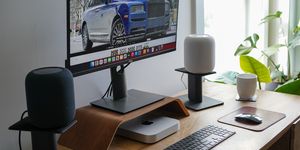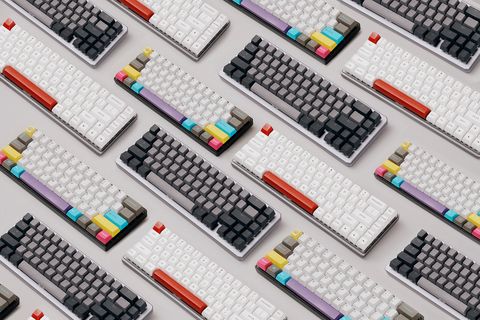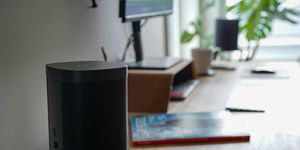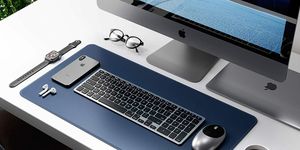It’s probably not shocking to hear that there are premium keyboards for people who are going to type a lot and would like to be able to enjoy it. Sure, there are ancillary "practical" reasons to buy an expensive mechanical keyboard, which you can use to justify the expense to yourself — longer lifespan, sturdier materials, options to customize keys to your liking — but the primary reason you, or anyone else, is buying a mechanical keyboard is because you like how they feel (and sound).
What Are Mechanical Keyboards, Exactly?
So what is a mechanical keyboard? Well, it’s easiest to define it by what it’s not. A mechanical keyboard is not a "membrane" or "rubber dome" keyboard.
If you don’t know much about the keyboard that’s currently on your desk, it’s almost certainly what’s known as a "membrane" keyboard. These contain within them a layer of flexible rubber domes — almost like a layer of bubble wrap — between the keycaps you press with your fingers and the electronics underneath, which send an electric signal to your computer. These domes are what give your keyboard that "snap" (at best) or "mush" (at worst), when you press the keys.
Mechanical keyboards, by contrast, have a discrete plastic mechanism under each key. These tiny devices, the switches, are what give a mechanical keyboard its feel, which can vary wildly depending on what kind of switches you choose to use.
Some people (and keyboard companies) will claim that mechanical keyboards are better for various types of typing. As a keyboard nerd myself, and owner of a dozen or so, I’ve found this to be dubious at best. An expensive mechanical keyboard will not magically make you type faster; mechanical keyboards will not suddenly make you better at video games.
However, there are specialty mechanical keyboards that can make your life better in various ways. Some unusual keyboards have layouts that can improve your typing technique or provide a more ergonomically comfortable typing experience. Even so, these keyboards are not better because they’re mechanical; mechanical keyboards are much simpler to create in small production runs, making them ideal for niche products.
How We Tested
To learn more about our testing methodology and how we evaluate products, head here.
We've used myriad types of mechanical keyboards over the years, both out of necessity and desire. Our staff includes a number of mechanical keyboard enthusiasts who love geeking out over the varieties out there and customizing them to suit their wants and needs; it also includes several writers and editors who simply needed a new keyboard when their old ones wore out and decided to take a stab at using a mechanical model. (At least one of this continent was a heavy enough typist to spur an H.R. complaint due to the volume of his key clacking.)
The Best Mechanical Keyboards to Buy
Drop ENTR Mechanical Keyboard
For a professional keyboard at an extremely good price, you can hardly find a better deal on offer than Drop's "ENTR" keyboard. With an aluminum case and slick, angular design, the ENTR is exactly what it was designed to be: the perfect entry-level mechanical keyboard. Available with smooth Gateron Yellow switches or tactile Halo True switches that offer a satisfying bump, the ENTR is not only grown-up looking but also reasonably quiet in all of its available configurations.
Fujitsu Realforce R2 Keyboard
There’s debate among the mechanical keyboard-crazed as to whether a Topre switch keyboard should be considered mechanical. But, by and large, it’s considered part of the crew. It uses a rubber dome with a spring under it and a capacitive sensor that senses the key being pressed mid-actuation, thereby registering a keystroke near the top of the press and with very, very little pressure or sound output. Frankly, it begins to feel a bit like there’s not even a keyboard there. The Realforce model, one of a handful of keyboards to use these switches, also features a heavy body and the decidedly superior PBT keycap (which doesn’t become glossy with use, more durable) instead of the typical ABS. You will pay a pretty penny for this board, but it is regarded by many enthusiasts to be the absolute pinnacle of the form.
Drop + OKLB Preonic Keyboard
The Massdrop x OLKB Preonic Mechanical Keyboard is a nerdy variety of mechanical keyboard that uses a different layout strategy known to ergonomic geeks as "ortholinear." Instead of needlessly staggering keys to prevent non-existent jams, an ortholinear keyboard arranges its keys so that no heavily-used key is more than one space away from the finger assigned to press it. That way, the logic goes, your fingers don’t need to move as far and so can make their movements faster and with less stress and strain. It’s a half-measure approach to improving ergonomics versus more extreme alternatives like switching away from QWERTY entirely.
There are about a bajillion other similar keyboards that follow these same principles, with different features and priorities, but this is one of the most accessible for normies.
Corsair K68 Mechanical Gaming Keyboard
The term "gaming keyboard" is more about aesthetics than anything else. You can game well with any keyboard, mechanical or otherwise. When it comes to mechanical boards that have that flashy vibe, however, the Corsair k68 is among the best you can get for your money. With a full layout including a number pad and a price that doesn’t break the bank, the K68 fits most gamer dens. And it also supports the one feature that might help you up your game: programmable macro keys.
Drop Sense75
The Drop Sense75, available in black or white, is the company's latest top-of-the-line mechanical keyboard. It has a "gasket-mounted" design — meaning there's cushioning between the metal plate that holds the actual keys and the metal body of the keyboard — which gives it a subtle, cushioned feel. It has a hefty, robust aluminum case that feels premium and substantial — it won't move around on your desk. But its standout feature is the little knob known as a "rotary encoder," which has pleasant knurling and very distinct clicks. It makes adjusting your volume easy and enjoyable, making this a great pick for anyone who keeps their laptop clamped shut and uses this keyboard as a peripheral.
HHKB Professional Hybrid Type-S
Mechanical keyboards are not especially quiet, and certainly, none is "silent." But! Some are quieter than others. The first step to a quieter keyboard is to opt for quieter (read: non-clicky) switches. But for maximum out-of-the-box quietness, look no further than the Happy Hacker Keyboard Type-S. With Topre switches (which are part rubber, part metal), built-in sound-dampening O-rings, and plastic construction, the HHKB is about as quiet as it gets. Of course, unfortunately, it’s not cheap.
Anne Pro 2 Mechanical Wired/Wireless Bluetooth
Even with their premium price tags, the lion’s share of mechanical keyboards are wired. But there are some wireless models around. The Annie Pro 2 is one of the best at a relatively low price point. Designed for portability, it also has a compact layout, so don’t expect a numpad here. Our pick for the quietest keyboard, the HHKB, is also a legendary wireless option at a premium price.
Qisan Magicforce 68 Mechanical Keyboard
While mechanical keyboards have a reputation for being expensive, there are some cheap options as well, which are still an upgrade over membranes. The Qisan Magicforce 68 is a perennial pick that comes in around $40. You get what you pay for: the Magicforce is neither feature-packed or something you can expect to pass down to your grandkids, but it’s a great way to try out mechanical, and you can make it feel much more premium with a set of aftermarket keycaps.
Das Keyboard MacTigr
Most mechanical keyboards come with key legends designed for Windows computers. They’ll work just fine on Mac, but you’ll be hitting the Windows button for CMD, etc. For a native Mac layout, an excellent option is the new Das Keyboard MacTigr, which not only comes with the option for Mac-style command keys but also connects by USB-C.
What to Look for in a Mechanical Keyboard
Which switches should you choose?
There are hundreds of varieties, many of which are hard for even aficionados to tell apart, but for a newb there are three main flavors to consider: "linear," "tactile," and "clicky." Each of these three flavors tends to come in two varieties of stiffness, where a stiffer switch requires more force to press down.
Linear switches are switches that simply go up and down with no gimmicks. When you press a linear switch, you’ll feel it depress smoothly until it’s all the way down. This is the vanilla of mechanical switches: it is very good and very enjoyable, but it is also very simple. If you see a switch called a "red" or a "black," it is almost certainly a linear switch. Blacks are typically the stiffer of the two.
Clicky switches are the other end of the spectrum. Clicky switches have two parts inside of them that smack against each other as you press them down, which results in a satisfying sensation for your fingers as well as a clicky noise that you may enjoy but that other people in the room will almost certainly hate. If you see a switch called a "blue" or a "green," it is almost certainly a clicky switch, and greens tend to be the stiffer of the two.
Tactile switches are something of a fusion of these two options. Tactile switches have a "bump" on the way down, a small physical sensation that is reminiscent of a click but much more subtle and, perhaps more importantly, entirely inaudible. Tactile switches are a little rarer than linear or clicky switches but are very popular among enthusiasts for this best-of-both worlds-quality. They’re also, by far, my favorite. If you see a switch called a "brown" or a "clear," it is almost certainly a tactile switch, and clears are generally the stiffer of the two.
(There is also something called "topre" but that’s another can of worms and, arguably, not strictly "mechanical").
Your first consideration for your choice is to be sound. Don’t buy clicky switches if you work within earshot of family or coworkers!!! Their high-pitched clicks tend to be particularly irritating to bystanders. While linear and tactile switches lack an annoying "click," they do still make considerably more noise than a membrane keyboard. If that prospect makes you self-conscious, my go-to solution is not to give up the dream but rather to convince a coworker to buy a mechanical keyboard as well, so you are not alone. You can also opt for specialized keyboards that are designed to be quiet, but even these make noise.
The second consideration is feel. You can buy switch testers like this 9-Key Cherry Tester ($18) which will give you the opportunity to feel everything you’ve just read about, and for a reasonable price.
How to Pick Your Size and Layout
Once you’ve settled on your switches, the hard part is over. But there are still a few more considerations. Keyboards come in a wide variety of shapes and designs. Some are truly wacky but by sticking with more traditional rectangular boards, you have three main options as to size and style.
Full-size keyboards have all the keys you could ever want: a full suite of letters and numbers (obviously) but also arrow keys, a row of F1-F12 function keys above the numbers and a dedicated numpad. This is your safest bet, with a few minor downsides. Bigger mechanical keyboards are generally more expensive, and they have a larger footprint on your desk.
Tenkeyless boards are full-size keyboards but without the numpad. Simple! After all, you can just pick up a numpad separately if you really miss it.
60 percent keyboards dispense with the Numpad, but also function keys and, most notably, arrow keys. In lieu of dedicated keys for these functions, 60 percent boards make use of a feature called layering. Just like you would hold shift to access the "layer" of keys where symbols like @ and * live on a normal keyboard, 60-percent keyboards use an additional "function layer" to give you temporary access to the keys it is missing. Some slightly larger keyboards known as 65- or 68-percent keyboards, find a way to cram in those arrow keys somewhere by getting creative with the size of certain keys.
Unless you use the numpad on a very regular basis, get a Tenkeyless. Smaller 60 percenters are very popular for their minimalism and portability, but I would advise against choosing any keyboard that does not have arrow keys. If you’re anything like me, you will miss them far, far more than you expected to.
What to Know About Keycaps
Keycaps should be the least important part of your decision because they are the easiest (and most fun) to replace.
Unlike membrane keyboards, where the keycaps are typically permanently attached to the board, a mechanical keyboard’s keycaps are removable. This means that you can pull off that stock plastic and replace it with all manner of colorful alternatives. This is how you turn the mechanical keyboard you bought into your mechanical keyboard.
Keycaps come in various different materials. PBT plastic is generally the most sought after for its subtle texture and ability to hold up well over time. Keycaps made with ABS plastic are much more common and still look and feel nice, but have a tendency to wear over time and develop a smoothness and a shine (especially on your most used keys).
Budget sets of replacement caps can be found on Amazon in the $30-50 range. But while colorful and widely available, they’re generally made out of low-quality plastic and a pretty limited variety of colors. More esoteric and high-quality keysets are generally produced in small runs, are only available for limited times through boutique websites and may cost as much if not more than what you paid for the keyboard itself.
For an idea of the range of options that are trendy with enthusiasts, scope out a mechanical keyboard haunt like r/mechanicalkeyboards on Reddit. For an idea of what is available for purchase at the moment, you can scope out reputable boutique retailers like Drop, Pimp My Keyboard, and Originative Co. Just be prepared to wait; orders for new keysets are often taken long before the keys themselves are actually in production.
When it comes to mechanical keyboards, 20 percent of the decision is finding a quality product, and the other 80 percent is a matter of taste. Here are our picks for keyboards that absolutely will not let you down – if they suit your style.






































